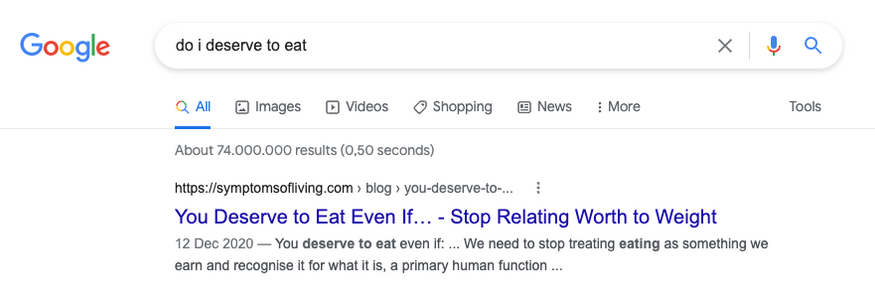5 Ways to Optimise an Existing Blog Post for SEO
Published on 8/3/2022
When I’m not here, unburdening my trauma onto the internet, I work as a SEO specialist for a travel company. I’ve been doing this for over four years and learned a lot along the way. Namely, that people who claim to know SEO may often have a very limited grasp on it.
Because all people mention are keywords. They namedrop keywords as if that’s the entrance code to the first position on Google. People will tell you to look up the keywords and mention them constantly in your article, as if that’s enough.
Well, I’m sorry to break it to you, but keywords are no longer enough. Google is too smart, and so all that low-quality content that relies on a few golden words will not be able to fight through the neverending quantity of content out there.
I tested this myself with my blog, Symptoms of Living, where I didn’t do keyword research. I just wrote about topics that interested me. I didn’t pay for backlinks either. This was a no-budget, passion project. And now, I have several articles in the top positions on Google. Because even though I didn’t write with SEO intent, I know it well enough to naturally optimise my blog posts.

And now you can too. Here are five ways to optimise existing blog posts without sacrificing quality, passion or sanity. You can still focus on being the best writer you are and have your articles found easily on Google.
1. Layout
Nowadays, content should always be optimised for mobile as well as desktop. To do this, use smaller paragraphs. Don’t take it to the extreme that some bloggers do, where it’s a sentence per line, as Google has been known to punish such content, assuming it to be superficial and ‘clickbait’.
Just let it flow naturally and consider it almost like a conversation. When would you pause? When would you move to the next subject?
Aside from using small paragraphs, aim to also make your layout interesting for a reader. Always use at least two headings, preferably in H2. These titles are a great way to communicate to Google what your article is about, so it knows when to recommend it to people searching. They also break up the text nicely. I also love using headings to keep me focused on the topic at hand; they ensure my content is concise yet detailed.
A simple way to further optimise your text for SEO is to use lists. It doesn’t matter whether they’re bullet points or numbered. You can also list your headings, as I have in this article. There’s still debate whether hashtag lists are as effective (e.g. #1 and #2) as some SEO writers believe that Google doesn’t read these as clearly, but nothing is for sure.
2. Meta title + Meta description
Your meta-title and meta-description are a chance to directly entice your reader. These refer to the text that appears on a search result. Your future reader will look through these to decide which link to open.
They’re also a chance to tell Google what you want to be found on. Use very specific, and simple, text for these. Don’t use a dramatic or subtle headline. Tell the reader and Google exactly what your article will be about.
For meta-titles, I like to use a hyphen in the middle for the chance to have two titles. This allows me to use all terminology relevant to my article.
For example, here’s the meta-title and description for this article:
5 Ways to Optimise an Existing Blog Post for SEO - Non-Keyword Ways to Improve Your SEO
Forget keywords; here are 5 different tactics for improving your blog's SEO. Use these 5 SEO tips to optimise an existing blog post with little effort.
3. Links, links and links
Never underestimate the power of links.
Let’s start with external links. It’s beneficial to have at least two outbound links in your blog post. Make sure these are relevant to the topic at hand; otherwise Google might think you’re being paid to link to them.
In an article about camping somewhere, I’d link to the campsites I mention. In an article about apps for staying in touch with long-distance friends, I link to the apps listed. If I’m writing about depression, I might link to another article that supports the point I’m discussing or explains a specific symptom or treatment in more detail.
These external links should be supplementary to the topic you’re discussing and on high-quality websites. This shows Google that you’re adding value to your blog post (more on that later!) and that your blog post offers supplementary reading. This will place your article over someone else’s. And if you write strong enough content, people will link to you as well for their external links. This will build your website score with Google and ensure you’re shown to people more often.
Now for internal links! These are links to your other blog posts or sections of your website. So, I actually just gave you an example when I linked to my article on apps for long-distance friends.
Many assume that internal linking is just about keeping someone on your website longer. And while that’s great, and shows Google people stay on your content and enjoy it enough to visit other pages, that’s not the only benefit of internal linking. It’s also an opportunity to tell Google exactly what an article is about.
When you link to another blog post, don’t link on generic words like ‘read’ or ‘here’. Link on words that describe exactly what that blog post is about. This is called your anchor text, and it helps Google know when to show your article. Then if someone types similar words into the search bar, Google will know that your article is relevant, as it’s often linked to by those terms.
For example, you might want to read this article on what it’s like to work in Content Marketing.
It also just confirms to Google that your content is relevant to each other and useful enough that you’d refer to it in other articles.
4. Question box
One of the Google core updates led to a question box in the search results. You might not be able to picture it, but I have no doubt that you’ve used it.
We’re not exactly sure how Google chooses which websites to feature there, but we have found that you can try your best to be included. When looking at your article, consider what questions it answers. What could someone look up on Google that would lead to your blog post as the answer?
Then make sure to answer this question in a sentence so Google has the option to preview your website. It can seem like you’re giving away your topic immediately then, but in reality, you’re building trust with your reader, and they’ll likely keep reading to get more details.

5. Value
This is the core of my SEO strategy, and I’ve seen it work at my regular job as well as my blog. Nowadays, we’re so focused on churning out content that we forget about value. And Google can tell; it really can. Your SEO score isn’t just measured by the content on your page but by how people react to it. Google watches how long someone stays on your blog post, whether they scroll down, if they click on links if they return, and more. Visitor behaviour will help Google decide whether they should bring more people to your website.
The main question I ask myself when writing is:
What am I giving the reader that no one else is?
Your content can stand out through the value you offer to visitors. You get to decide why someone should choose your blog post over another and why they should stay. Do you have personal insight that others don’t? Do you take a different angle? Do you offer more detail?
The last one is usually my approach. For my job writing travel content, I aim to give all the information a reader needs. When I write about a road trip, I don’t just mention destinations, I plan an entire itinerary for them. I tell them the best accommodation for each stop, with price and location. Since adding the GPS and price to these blogs, I’ve watched them soar through the results page until they’re always in the top three. Because Google picks up on those extra details and rewards my content for it.
Never forget why you’re writing a blog post, and always ensure it’s giving something to a reader. You get to decide what that something is.
When it comes to improving the SEO of your website or blog, it’s about being in it for the long haul. You’ve got to regularly publish high-quality content and then simply hope for the best. You’ll often be surprised at which blog posts end up ranking well and getting lots of traffic. We can never predict what Google will respond to. But by following these 5 tips for optimising existing blog posts- and not falling into the trap of keyword stuffing- you’re doing everything in your power to have your content seen by as many people as possible.
If you have any other questions, pop them in the comments!
Featured posts

Fleur
Welcome to Symptoms of Living! A place where I like to relieve myself of the barrage of thoughts and ideas filling my mind. Here I'll take a look at various topics, from books to BPD, series to self-harm, there's nothing that we can't, and shouldn't, talk about.
Having struggled with mental illness since the age of 15, one of the hardest parts was how alone I felt in it. While mental illness is beginning to be discussed more openly, and featured in the media, I still think there is room for improvement. So whether it is mental illness or merely mental health, a bad day or a bad year, let's make this a place to approach it and strip it back. Everyone has their own symptoms of living, and you certainly won't be the only one with it.
Would you like to receive my top monthly articles right to your inbox?
For any comments/questions/enquiries, please get in touch at:
info@byfleurine.com
I'd love to hear from you!